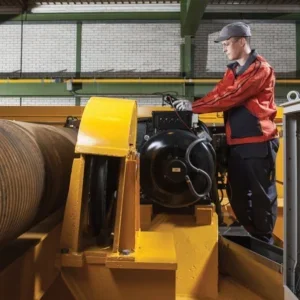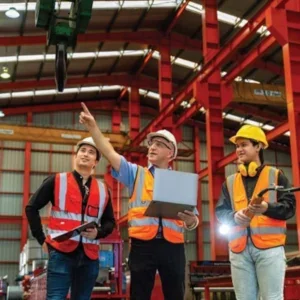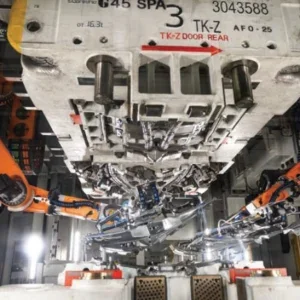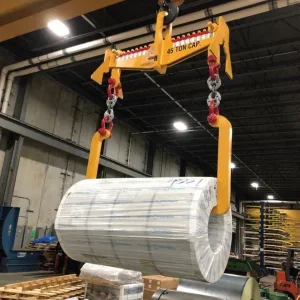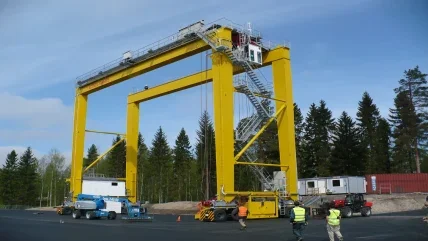
This year, TOC Americas – Building Local Bridges for a Global Supply Network – will include a twostream conference programme: Container Supply Chain and Tech TOC. The Container Supply Chain will deliver content through three themed days – Business Intelligence, Sustainability and Digitalisation – while the Tech TOC conference will offer sessions on technology, alongside the trade show exhibition that will showcase the latest innovations in the industry.
Kalmar
Kalmar has secured an order to supply ten Kalmar Hybrid Straddle Carriers to Patrick Terminals in Melbourne in Q1, 2024. As Australia’s leading container terminal operator, handling over three million TEUs annually, the company operates four ports: Brisbane AutoStrad Terminal, Sydney AutoStrad Terminal, Melbourne Terminal, and Fremantle Terminal in Western Australia.
“We are proud to be the first container terminal operator in Australia to invest in the Kalmar hybrid straddles and set new benchmarks for more environmentally friendly container handling,” says Michael Jovicic, CEO, Patrick Terminals. “We understand the importance of reducing our carbon footprint and promoting environmentally responsible practices. Together with our trusted partner, Kalmar, we have a shared dedication to building a more sustainable industry. By investing in these hybrid straddles, we are making a strong commitment towards our decarbonisation journey.”
Allan Baker, sales director APAC Horizontal Transportation, Kalmar, says the Hybrid Straddle Carriers can cut fuel consumption by up to 40% compared to equivalent diesel-powered machines and will play an important role in supporting Patrick Terminals decarbonisation strategy.
Bromma
Bromma has taken inspiration from the gaming world, where character health is evaluated based on their virtual performance, to launch a Spreader Monitoring System (SMS) to improve crane efficiency.
It’s known that up to 50% of quay downtime is caused by the spreader. Factors such as harsh weather conditions and landing impact forces put the spreader to the test. To address this challenge Bromma has devised an algorithm that assesses the health of the spreader. By analysing sensor signal stability, motor power consumption, internal faults, and the number of moves performed, the algorithm provides terminal operators with vital information to enhance operational efficiency and prevent costly interruptions.
The Bromma SMS visually represents the health of the spreader fleet through an intuitive green/yellow/red signal visualisation. A green signal indicates a spreader in good condition, while yellow suggests some level of issue that should be addressed at the next planned stop. Red signifies a spreader requiring immediate attention.
By acting upon the health indications provided by the SMS, terminal operators can proactively address spreader issues and avoid costly crane downtime. The system not only predicts potential problems but offers detailed information about the issue and provides step-by-step instructions for maintenance personnel, saving valuable time and further reducing equipment downtime.
ZPMC
ZPMC China has successfully delivered a quay crane and two rubber-tyred gantry (RTG) cranes for TPE Peru and four RTG cranes for TPG Ecuador.
TPE Peru’s quay crane spreader has a capacity of 65 tons, a large track gauge of 30.48m, a front outreach of 67.7m, a back reach of 17m and a lifting height of 45m above the track and 20m below the track. The RTG crane has a span of 26.5m, a rated capacity of 41 tons, a trolley travel of 18.5m and a lifting height of 18.2m.
TPG Ecuador has four RTG cranes with a span of 23.47m and 26.5m, respectively, a rated capacity of 41 tons, a trolley travel of 21.5m and a lifting height of 21m.
Dellner Bubenzer
Dellner Bubenzer has expanded its team in Latin America, hiring Andrés Bonfante as regional sales representative, Latin America.
Bonfante has spent the past eight years working with Keyport in Cartagena, Colombia, as a lead sales engineer and has a wealth of experience with regards to the legacy Pintsch Bubenzer products.
Within this role he will report to Ezequiel Ivitz, MD, Latin America, and Edgar Roca, VP/MD, Dellner Bubenzer.
“The Latin American market is always a great challenge for Dellner Bubenzer, mainly due to logistical problems, and in some countries also due to the constant changes in policies related to Comex [commodity exchange],” says Ivitz.
“To overcome the problems, we have worked hard to understand the needs of customers to identify those critical spare parts and increase the stock in our warehouses in the US. Likewise, last year we began to carry out training sessions to the main port terminals to make technicians and engineers aware of the problems that may arise from not carrying out maintenance according to the manufacturer’s standards.
“Last but not least, Andrés joined our team in June. Andrés has extensive experience in the port market and different types of industries and his main objective within the group will be to expand our presence in the mining market and provide better support to our clients in Central America and the Caribbean.”
At Keyport, Bonfante was trained in multiple technologies such as braking systems, mechanical couplings, encoders and control systems, and maintenance of port equipment. He holds an Industrial Engineering Degree from the Universidad Tecnologia de Bolivar in Colombia and is a certified quality auditor.
Igus
Igus has partnered with Sanmar Shipyards to develop an ‘electric bunkering’ system that can supply various vessel types with onshore power.
The two companies have designed and built a compact quayside shore power dispenser system that can be operated by just one crew member.
The modular design allows an extension of the dispenser system to provide higher charging power capacities. Each cable dispenser module can handle 500A current capacity (up to 1,000V AC).
For Sanmar, as a Turkish shipyard and tugboat operator, the cooperation with Igus means it can offer a charging infrastructure for the ports. It is part of the company’s mission to contribute to the tug and workboat industry’s efforts towards an environmentally friendly, sustainable, low- and zero-emission future.
Sanmar is working with Canadian naval architects Robert Allan and Corvus Energy to build an ElectRA range of electric tugboats: five vessels ranging from 19m to 28m in length and up to 70 tons of bollard pull.
Konecranes
Finally, as the event is taking place in Panama, we’ll end with the news that Konecranes delivered three rubber-tyred gantry (RTG) cranes to PSA Panama earlier in the year. This was the first order from PSA Panama for Konecranes.
The RTG cranes strengthen the terminal’s container handling equipment fleet, now comprising 12 RTGs and 12 rail-mounted gantry (RMG) cranes that handle the terminal’s increasing container traffic.
The new RTGs are diesel-electric and equipped with Konecranes’ Diesel Fuel Saver technology and the Auto-Steering and Stack Collision Prevention smart features. TruConnect remote monitoring is also included. The RTGs will stack containers up to five containers high and six container rows wide plus a truck lane.


